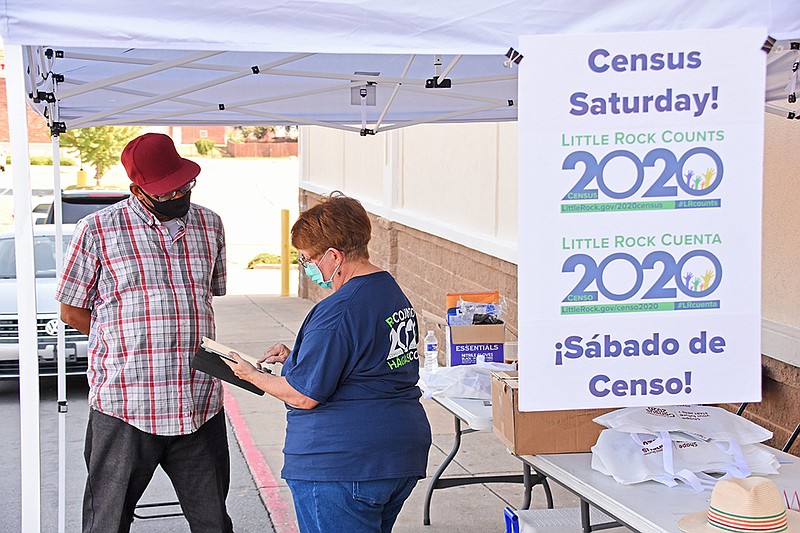The 2020 census count, which will help determine how trillions of federal dollars will be spent for the next decade, is finished in the state.
A smaller percentage of Arkansans submitted responses on their own this time than in 2010 (60.6% compared with 62.3%), although the totals aren't official and some data may not have been entered yet. The U.S. Census Bureau says 99.9% of the state's population of about 3 million people has been counted through home visits by census-takers and responses by proxy, such as a landlord on behalf of a tenant.
It's unclear how that 99.9% figure compares with previous census years because of differing methodology. The only comparable pieces of data are self-response figures -- people filling out the forms themselves and sending them in. Self-responses are considered more reliable, although many visits to households that haven't responded result in survey information from household members themselves.
Arkansas political and nonprofit leaders and volunteers spent the better part of the past two years preparing for census outreach and carrying out those plans once the census form went online in March.
Despite officials' months of determination to get more Arkansans to respond than last time, the coronavirus pandemic shut down many of the efforts to reach people, with the events that leaders had planned to target with volunteers and census-information tables being canceled.
"Covid-19 really put a damper on everything, basically," said Mary Liddell, chairwoman of the Pine Bluff Complete Count Committee. "For us to do as well as we did, it was by God's grace and mercy to get to the percentage we did get."
The census ended later this year than the usual July 31 deadline because the pandemic delayed census-takers' visits to homes, and because of national concern that the closure or limiting of gathering spaces would scuttle many plans to reach people. Ultimately, the Census Bureau decided to end the count Oct. 31, before changing course as the Trump administration sought to shift the deadline to Sept. 30. A lawsuit followed, and the U.S. Supreme Court permitted the count to continue through early Friday morning in Arkansas.
Arkansas had one of the lowest rates of self-response in the nation, but the state's overall percentage of residents counted -- at one point among the highest in the nation -- can be attributed to the follow-up visits to nonresponsive homes.
Pressure from politicians, nonprofits and volunteers helped. Brad Cameron, a spokesman for the Arkansas Counts committee, said one mayor in east Arkansas even volunteered to visit houses with a census-taker to encourage residents to fill out the form.
"I would say it has been much more locally driven [than last time]," Cameron said. More people volunteered this time, too.
Cameron said he was encouraged by the 99.9% estimate.
"That's huge success for a state as rural as our own," he said.
Many leaders were worried about Arkansas' lower internet connectivity rate compared with other states, and about the census debuting an online form this year. The Census Bureau sent paper forms to a large share of Arkansas that was considered less connected.
Still, many people reported not receiving the paper forms, especially those who use post office boxes, Cameron said.
Gathering responses was a major volunteer endeavor, even in cities.
Pine Bluff's self-response rate was 53.6% as of Friday, although Liddell said she knows some data hasn't been included yet. She said she believes the final percentage will end up being higher. The city's 2010 self-response rate was 60.5%.
The city's population is estimated to be much lower than it was in 2010, and officials tried to make sure everyone who lives in the city was counted for every dollar of federal funding that might be at stake.
Liddell's committee invested money into the effort in the form of gift cards, candy, water bottles -- anything that might incentivize people to stop by an event and fill out the census form. The University of Arkansas at Pine Bluff donated sweet potatoes for one event that Liddell called a "roundup," where volunteers tried to "round up" as many people as they could in a certain part of the city to attend an event where getting people counted was the ultimate goal.
Even through the pandemic, volunteers set up tables outside to draw people from churches, the skating rink and the bowling alley. UAPB fraternity members also canvassed neighborhoods to help people respond, much like a census-taker would.
But one thing the pandemic prevented was crucial to Liddell's original plan. She had about a dozen computers that were supposed to be set up at different sites around the city for people to use to fill out the census form.
Many people don't have computers at home, and they needed access to one to fill out the form if they didn't want to do it over the phone or didn't receive a paper questionnaire to mail back. The pandemic closed many of those sites, and people at first weren't able to take the bus to get to the ones that were open.
Pine Bluff was a good example of a city of leaders and volunteers who came together in an effort to get as many people counted as possible, Cameron said, but the one lesson learned during this decade's census was that officials need to start planning even earlier to ensure a better count next time.
